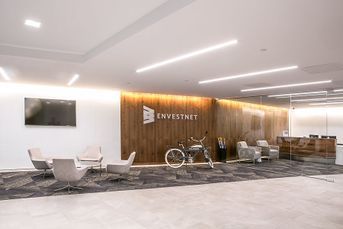Michael Kitces: The Latest In Financial Advisor FinTech — July 2018

This month's edition kicks off with the big news that robo-advisor-turned-enterprise-digital-advice platform SigFig has raised a whopping new $50M round from famous VC firm General Atlantic.
Welcome to the July 2018 issue of the Latest News in Financial Advisor #FinTech – where we look at the big news, announcements, and underlying trends and developments that are emerging in the world of technology solutions for financial advisors and wealth management!
This month’s edition kicks off with the big news that robo-advisor-turned-enterprise-digital-advice platform SigFig has raised a whopping new $50M round from famous VC firm General Atlantic, while U.S. Bank announced that it has (finally) deployed its “Automated Investor” robo solution via FutureAdvisor, and Fifth-Third Bank is rolling out its OptiFi digital advice offering (a white-labeled version of Fidelity’s AMP). Which means, after years of buzz, the shift from B2B to B2B2C robo-advisor technology appears to finally be gaining traction, as the startups figure out how to attach next generation modern technology to prior-generation legacy software of the incumbents, and large firms gear up to see whether or to what extent they can really cross-sell managed ETF accounts to their (existing or new) clientele.
From there, the latest highlights also include a number of interesting advisor technology announcements, including:
• AdvisorEngine deepens its rebalancing software integration with SmartLeaf
• Grove raises an $8M Series A round to scale its virtual-CFP financial planning subscription service
• Ethos Insurance and Ladder Life raise new capital to see if life insurance can be bought by consumers (rather than sold to them) by making it easier to purchase in the first place
• SmartAsset raises a whopping $28M Series C round to scale up its new SmartAdvisor lead generation program
Read the analysis about these announcements, and a discussion of more trends in advisor technology, in this month’s column, including RiXtrema launching a new prospecting tool in the 401(k) market, Orion establishing a data integration with Lincoln Financial to facilitate RIAs using fee-based annuities, Morningstar launching a new Investor Pulse competitive and business intelligence tool for asset managers to show them why their funds are failing to attract investor flows, and the big reveal of a fascinating new pivot from Wealthfront into what may finally be a truly new and uniquely differentiated holistic financial advice platform, focusing no longer on just a managed investment account or even traditional financial planning advice, but moving into the true core and lifeblood of a household’s financial life with tools to automate managing household cash flow.
And be certain to read to the end, where we have provided an update to our popular new “Financial Advisor FinTech Solutions Map”, including a number of new companies and categories!
I hope you’re continuing to find this new column on financial advisor technology to be helpful! Please share your comments at the end and let me know what you think!
*And for #AdvisorTech companies who want to submit their tech announcements for consideration in future issues, please submit to [email protected]!
SigFig Raises $50M Series E To Expand Capacity As The B2B2C Robo Model Accelerates. This month, robo-advisor-for-advisors SigFig announced a whopping $50M Series E round (bringing their total capital to $117M), funded by late-stage venture capital firm General Atlantic (also known for investing in Facebook, Alibaba, and AirBNB). The influx of capital is a huge confidence boost to the B2B2C “robo-advisor-for-advisors” model that SigFig (and many others) pivoted to in 2016 when it partnered with (and took funding from) wirehouse UBS, and later expanded to work with Wells Fargo and Citizens Bank as well. In fact, General Atlantic reportedly had decided to wait and not invest in early B2C robo-advisers that were struggling in the war for costly client acquisition and facing slowing growth rates, and instead view SigFig as more of a large-financial-services-firm technology infrastructure play as SigFig increasingly integrates to and overhauls the wirehouses’ existing technology. And SigFig CEO Mike Sha himself reports that the entire venture round will go towards engineers and product managers, and not client acquisition. Not to say that SigFig isn’t powering actual client results; it’s the core of the UBS Wealth Advice Center, which for 75 bps provides the SigFig dashboard of portfolio diagnostics, goal tracking features, and a UBS managed account solution. Instead, the momentum for SigFig appears to be driven in part by recognizing that “robo” tools are really a back-office operations and infrastructure play and not a direct path to (young) clients, while large firms like UBS that already have retail distribution capabilities are the ones that can best put it to use (while most independent advisers can’t).
The bottom line, though, is that General Atlantic’s big investment into SigFig is the strongest signal yet that the overhaul of legacy financial services technology systems into modern “robo-style” tools is still only in its nascent stages, as robo-automation technology finally finds its proper home powering back-office and middle-office systems (and not just as a direct-to-consumer niche solution).
U.S. Bank (Finally) Launches “Automated Investor” Robo-Service With FutureAdvisor. This month, U.S. Bancorp announced the official launch of Automated Investor, its “digital advice” platform that puts self-directed investors through a basic data gathering, risk tolerance assessment, and retirement projection process, and then automatically invests and rebalances clients into a diversified managed ETF portfolio for a 0.50% fee with a $10,000 minimum (with access to a call center service desk, but not dedicated advisers, for those who have questions or need further assistance). What’s notable about the announcement is not the launch of the service itself – which is not substantively different than a whole host of other large firms launching “robo” solutions – but that it is just now launching, nearly two full years after the partnership was first announced in mid-2016 (with an originally anticipated launch date of early 2017). Representatives from U.S. Bank simply state that it had “spent the time since then perfecting the service in various beta launches,” gently underscoring the challenges that many direct-to-consumer robo-advisers appear to have had in re-engineering their technology to fit legacy large-financial-services-firm systems (and why it’s significant from a pure execution perspective that SigFig was able to get their 2016 partnerships with UBS and Wells Fargo to the deployment stage last year). Nonetheless, now that the system is launched, U.S. Bank is looking to ramp up adoption of the solution across its existing channels, and notably suggests that it sees a good fit for the new managed account solution for any clients who want to delegate their investment management needs using the technology, not just millennials.
Fifth-Third Bank Launches White-Labeled Fidelity AMP Digital Advice Solution Dubbed OptiFi. Continuing the theme of large firms launching their robo-adviser-for-advisers or “digital advice” platforms, this month Fifth-Third Bank announced the launch of its OptiFi solution, with a 0.50% fee and a $5,000 minimum. Similar to digital advice platforms, OptiFi will offer an ETF managed account after clients go through a guided process of evaluating goals and risk tolerance, with access to a call center service team for basic support. What’s more notable from the industry perspective, though, is that OptiFi is built on top of the Fidelity Automated Managed Platform (AMP), which in turn was co-developed with Fidelity’s eMoney Advisor financial planning software and includes a far more in-depth financial planning and personal financial management dashboard experience than “just” the robo-investing dashboard of the competing B2B2C solutions. Of course, at this point most financial services firms that launch robo-adviser and digital advice platforms will live and die by their ability to market and distribute the solution – not merely for the financial planning depth (or not) of the software’s capabilities themselves. Nonetheless, the Fifth-Third Bank launch marks not only an emphasis on the rapidly accelerating trend of large financial services incumbents finally rolling out their “robo” and digital advice solutions, but is setting the stage for another showdown in 2-3 years as we see which types of digital services really gain adoption, traction, and most importantly retention with consumers (or not).
AdvisorEngine Deepens Rebalancing Software Integration With SmartLeaf. Digital advice technology platform AdvisorEngine is one of several competitors in the “robo-advisor-for-advisors” category that started out as direct-to-consumer and pivoted later to advisors. While competitors like SigFig have focused in the wirehouse and large-firm channel, Trizic in the bank channel, and FutureAdvisor in the broker-dealer channel, AdvisorEngine has focused primarily in the RIA community, aiming to provide an increasingly all-in-one solution for investment-centric advisers to run their firms. As with most “digital advice” platforms for advisers, AdvisorEngine can facilitate digital onboarding of new clients and now has an increasingly deep CRM integration to Junxure (after acquiring them at the beginning of this year), along with delivering a basic risk tolerance questionnaire and supporting the completion of account applications, offering an account aggregation and document vault portal, and providing tools to create model portfolios (or a Model Marketplace to select them). However, AdvisorEngine is not actually built to trade and implement portfolios, and as a result has had to rely on integrations with third parties like FolioDynamix, iRebal, Orion, and SmartLeaf. But now, AdvisorEngine has announced a much deeper integration with SmartLeaf in particular, to facilitate deeper workflows around both onboarding and initial client implementation, and ongoing rebalancing and order tracking. The upshot of the deal is that deeper integrations with more effective workflows should be much more effective at actually providing measurable productivity improvements for advisory firms, which is essential for AdvisorEngine (or any digital advice provider) to convince existing firms to actually make a change and adopt the solution. On the other hand, the fundamental challenge is that the deeper platforms like AdvisorEngine go with individual partners, the harder it is for the software to fit into the ecosystem of existing advisory firms (that may, for instance, have already been using some other rebalancing software tool), limiting AdvisorEngine’s appeal for all but the newest of firms that don’t yet have their infrastructure in place anyway (or at best existing firms that were technology laggards). From the tactical perspective, though, arguably the best appeal for AdvisorEngine in partnering with SmartLeaf is simply that they’re the least likely to be direct competitors to AdvisorEngine in the first place, especially relative to the growing digital capabilities of AdvisorEngine’s other rebalancing partners FolioDynamix, iRebal, and Orion… another indication of the challenge that occurs more and more niche adviser solutions try to become the same all-in-one platform and end out in competition with one another, while advisers are stuck trying to figure out which platforms and partners will survive. Nonetheless, AdvisorEngine is clearly positioning itself to survive and thrive, as this month it also announced a full re-architecture of its back-end to facilitate more scalable growth in the future.
Grove Raises $8M Series A For Virtual Fee-For-Service Financial Planning Platform. In recent years, XY Planning Network has championed a model of providing financial planning for a monthly subscription fee as a way to expand the reach of financial advice to next-generation clients in various niches, given that Gen X and Gen Y consumers already pay almost everything else on a monthly basis. Now, a new tech-plus-humans startup called Grove is aiming to expand the model even further, offering a combination of its proprietary financial planning software, plus (virtual) access to a human CFP certificant, for a cost of just $75/month (albeit payable as a $900/year annual fee but with no separate upfront cost, and currently reduced to $50/month or $600/year as an “introductory offer”) and a tiny 0.25% AUM fee for supporting investment management services. Coming on the heels of a $2.1M seed round just a few months ago, Grove CEO Chris Hutchins states that the new capital is intended to both deepen and scale their technology tools, and the number of CFP certificants they have serving clients (with a current wait list for taking on new clients). For some, Grove may trigger echoes of LearnVest financial, which similarly sought to bring financial planning to the masses for a monthly fee with virtual CFP professionals, but was ultimately sold to Northwestern Mutual and recently saw its actual financial planning services shut down as Northwestern repurposed the technology for its core business instead. However, LearnVest had successfully attracted 10,000 “premium” clients paying its financial planning fees, albeit at a cost of just $19/month; at $900/year for Grove (discounted to $600 in the first year), Grove would be targeting more than 3X the revenue/client, at what arguably would be a more financially viable price point for the business, while still staying under the consumer’s mental barrier threshold of a $1,000/year fee. Is the fee-for-service financial planning retainer fee model about to go mainstream for consumers, as advisers choose whether to start their own businesses in the model via XY Planning Network, or opt for an employee path through Grove instead?
Ethos Insurance Raises $11.5M To Make Insurance Bought Instead Of Sold. There’s a long-standing saying in the industry that “life insurance is sold, not bought”, thus signifying the crucial role of the (human) insurance agent in persuading consumers of the need to plan for their future by buying insurance protection. Yet despite the persistent efforts of hundreds of thousands of insurance agents, the adoption rate of life insurance has fallen from 77% in 1989 to just 60% today. And while some would contend that the shift is simply due to the fact that life insurance was oversold as a savings product in the past (whereas now there are more affordable alternatives available), and others suggest that the decline is merely an acknowledgement that medical advances have reduced the risk of an untimely death in the first place, the fact that insurance adoption was once so high suggests there is still ample room for adoption to grow again… and that perhaps the best way forward is simply to make insurance easier to purchase in the first place. This idea has led to the growth of a new category of “InsurTech” technology startups that are aiming to create the “self-directed robo-adviser” experience for buying life insurance, where a brief number of initial onboarding questions are all it takes to complete the entire process. Ethos Insurance represents the latest newcomer to the space, licensed in every state but New York (as an overlay on Assurity Life) and asking consumers to complete just a 4-question process to get a quote and a 10-minute questionnaire to get a 10-30 year term insurance policy issued in most cases (as the company anticipates that fewer than 1% of its applicants will need a medical exam or blood test to get a policy). The intended appeal of companies like Ethos is not only to strip out the cost of insurance commissions paid to agents by going direct-to-consumer with technology (although notably, the coverage will still require at least some distribution costs for marketing), but that if insurance policies are easy enough to buy, that more consumers will buy at least term insurance even without an agent there to sell it to them… just as no-load mutual fund companies like Vanguard eventually proved that there’s a market for “simpler” no-commission direct-sold investment solutions as well.
Ladder Life Extends Series B Round With An Additional $10M Of Funding. While Ethos Insurance is the latest newcomer in the world of direct-to-consumer easy-to-purchase life insurance technology platforms, Ladder Life was one of the “early” players (along with Mass Mutual’s Haven Life), founded in 2015 and fully launched in 2017 with an eye on closing the nearly $15 trillion “life insurance coverage gap” (measured by LIMRA as the gap between the total insurance coverage that consumers should have based on their financial situation and needs, compared to what they actually do have). Similar to others in its category, Ladder Life attempts to drastically cut down on the input process to apply for a life insurance policy, and the time to issue one, by using technology tools to expedite the application process along with artificial intelligence and algorithms to expedite the underwriting process (and where feasible, offer “instant issue” policies). The additional $10M of funding brings Ladder’s total capital investments to $54M, and will reportedly be used for both engineers and product-focused teams for continued insurance innovations, and marketers to help distribute the policies (as even without insurance agents to sell the policies for commissions, the company must still do something to market and get the word out about its insurance solution to consumers). Ultimately, though, the question that still lingers for Ladder Life and the others, just as it did for the early stage robo-advisers, is whether the cost to sell and distribute “easy-to-purchase” life insurance to consumers is really lower than the cost of just paying an insurance agent to sell it instead, or if in the end direct-to-consumer client acquisition costs will be so high than the solutions must eventually be pivoted instead to be B2B2C insurance technology platforms for advisers to use to offer life insurance to their clients.
SmartAsset Raises $28M Series C In Shift To Advisor Lead Generation. For years, SmartAsset has been known primarily for its various personal finance calculator “widgets,” embedded in various consumer media sites through its Captivate platform. As a result of their Captivate reach, SmartAsset now reaches a whopping 45 million unique visitors every month, for which SmartAsset generates a profit by steering a subset of the consumers that use its widgets to product providers that help them implement (e.g., a mortgage calculator tool that turns into a lead for a mortgage lender through SmartAsset). However, earlier this year SmartAsset announced the next iteration of its monetization and lead generation strategy – steering consumers not just to financial product providers, but directly to financial advisers for advice as well, through a new platform called SmartAdvisor, which for a cost of $20 to $190 (depending on investible assets) will provide already-screened leads to up to 3 financial advisers. And now, the latest $28M Series C round is intended primarily to build and scale the SmartAdvisor platform, in an effort to attract both qualified advisers (who are screened for prior complaints/violations) and also optimize the funnel of converting SmartAsset Captivate widget users into qualified prospects that actually turn into clients for advisers. Ultimately, no platforms yet have managed to crack the secret of how to turn a scalable growing volume of direct-to-consumer marketing and traffic into consistent lead generation results for advisers, with successes thus far limited to more niche organizations like NAPFA that rely heavily on earned PR, and high-profile attempts like NerdWallet shutting down their adviser channel, due in part to the spiraling cost of client acquisition to scale the reach, and also simply because few consumers are necessarily willing to engage an adviser based on a single interaction with a consumer media website. However, arguably no platform yet, besides perhaps Investopedia, has even attempted the approach with the kind of traffic volume and reader attention that SmartAsset already has through its Captivate platform. Time will tell?
RiXtrema Launches 2.0 Version Of Its ‘Prospects Of Wealth” Stress Testing Lead Generation Tool. Until Riskalyze first showed up, “risk tolerance” solutions were generally little more than a questionnaire given to clients, either crafted by home office personnel, or relying on the expertise of a third-party-created solution like FinaMetrica. But what was unique about Riskalyze was not merely its particular series-of-tradeoffs questionnaire process to assessing risk tolerance, but the way it connected risk tolerance to the potential decline of a portfolio, including allowing advisers to either type in or account-aggregate-in a prospective client’s actual portfolio so they could see that they were under-diversified and that the potential decline was more than they were willing to tolerate. Its success helped to spur the growth of not only competing risk tolerance software solutions, but also other “stress testing” investment analytics platforms like HiddenLevers, MacroRisk Analytics, and RiXtrema, that profess to do a more ‘sophisticated’ stress test analysis. The caveat, however, is that while other solutions have come up with creative ways to analyze or show stress testing results, none have managed to replicate Riskalyze’s unique marketing potential to use the tool to easily show the problem to prospects. But now, RiXtrema, a portfolio stress testing tool that has increasingly focused into the 401(k) space by building out a “401(k) Fiduciary Optimizer” due diligence tool, is now also building out its own version of marketing and prospecting tools. Leveraging a database of qualified plan executives from their recent Larkspur acquisition, RiXtrema has announced its “Prospects Of Wealth 2.0” platform, which pulls available information on the qualified plan’s 401(k) menu, conducts a “Portfolio Crash Test” scenario analysis to show where the plan may have potential risks, and then provides the direct contact information (email addresses and phone numbers) of the relevant qualified plan administrators and executives to show them the results and solicit their business. Of course, the caveat is that there’s no way to know exactly how the plan is actually allocated – at best, the Stress Test analysis will typically be done just based on available menu of options – but nonetheless, the RiXtrema Prospects of Wealth solution is a notable and positive step in the direction of adapting their tool into not just an analytical and portfolio construction tool, but a marketing and business development solution that helps a wider range of advisers (and may be able to command a much higher price in the adviser marketplace, too).
Orion Establishes Data Integration Partnership With Lincoln Financial For Fixed And Variable Annuities. The flattening growth in broker-dealers and the rise of the RIA has not only shifted where and how advisers choose to build their businesses, but also the products that they use, as those in the RIA channel legally cannot be compensated with a commission for the sale of investments, insurance, and annuities (instead, they can only be compensated by fees the client pays for advice and/or ongoing management). In the context of investment products, the shift to RIAs appears to have accelerated a shift to no-load ETF products, with various mutual fund providers scrambling in recent years to come out with adviser-class, institutional-class, no-load, or similar “clean share” structures that can be used by RIAs. Yet while a similar effort has been made in the world of annuities, with various carriers offering “fee-based” variable annuity offerings (most notably, Jefferson National’s Investment-Only Variable Annuity [IOVA] product), the relative adoption of the RIA community has still been sluggish… as the reality is that while an RIA legally can’t sell a commission-based product and must have a fee-based version, eliminating the commission structure from annuities is a necessary-but-not-sufficient condition for RIA adoption. Because the challenge is that even with a viable product structure from a legal perspective, annuities do not fit into or integrate with existing RIA software systems, typically lacking data feeds to facilitate portfolio performance reporting solutions, trade integrations to various trading platforms, and administrative integrations to CRM systems to facilitate account opening and the tracking of transfers as well as the process of billing advisory fees. In this context, it is notable that this month, annuity provider Lincoln Financial announced a data integration partnership with portfolio trading and performance reporting solution Orion Advisor Services, which will allow Orion users to draw daily data downloads directly into the software to facilitate performance reporting and billing, in what may be the start of a new wave of integrations that make fee-based annuities finally feasible for the RIA community, not only from a legal commissions-versus-fees perspective, but by enabling and integrating to the requisite real-world workflows that RIAs use.
Morningstar Launches Investor Pulse To Help Asset Managers Understand Why They’re Losing Flows. Morningstar has long been used by advisers and investors to understand which mutual funds are performing better or worse than their benchmarks, and ideally to identify which funds will outperform in the future, from their famous Star Ratings to their more recent Analyst Ratings. Controversially, though, some research suggests that Morningstar Star Ratings in particular have at best only a light correlation to future outperformance, and a much higher correlation to fund flows. In other words, a 5-Star rating may not perfectly predict future outperformance on investment returns, but it does seem to predict (or likely, cause) future outperformance of fund flows. In fact, Morningstar itself published a paper several years ago, entitled “What Factors Drive Investment Flows?”, that showed high Star Ratings – along with other factors like cost (US investors show a strong preference to lower cost funds), indexing (equity funds do better when then index, while fixed-income and balanced funds do not), continuity of management, perceived firm quality, and more. Now extending this further, Morningstar has refreshed its study of flows for 2018, and launched a new tool called Investor Pulse, which rolls up all the internal research and metrics that Morningstar has on what predict fund flows (not fund performance, but actual investor flows) to help fund companies understand where they’re winning and losing, who they’re winning and losing to, and what kinds of factors they should consider adjusting to improve the fund’s competitive positioning if it’s a contender (or alternatively, to give up hope and just shut it down or consolidate it into another fund if it’s a severe laggard!). In essence, Investor Pulse is a competitive and business intelligence tool for asset managers, helping them to conduct their own SWOT analysis and visualize fund flows against their competitors. Because the only strategy that’s more effective than telling the asset management industry it’s issued too many funds and share classes at once without sufficient unique value or differentiation, is to give them the analytics tools and let them see it for themselves?
Wealthfront Preparing A Pivot From Managing Investments To Holistic Cash Flow Management Instead? Arguably, no robo-advisor has taken great abuse from the industry than Wealthfront, a firm that not only set as its founding mission to make human advisors irrelevant, but doubled down on the positioning last year when it launched its consumer-self-directed “Path” financial planning software. From an industry perspective, though, the significance of Path was not just Wealthfront’s bold statement that their software would be better than a human financial planner, but its particular focus on “non-traditional” planning modules that were most relevant to its Millennial clientele, including account aggregation to track cash flow and figure out what a client is actually saving and spending (while most advisors still spend little time on detailed cash flow planning), and helping them to model near-term cash-flow-intensive savings goals like buying a house or planning for college. And now in a recent interview at the CB Insights Future of FinTech conference, Wealthfront founder Andy Rachleff revealed that Wealthfront is looking to increasingly evolve from just investment and increasingly more planning advice, into being the entire “central financial hub” for its clients, including offering checking and savings accounts, and delivering a service where the software will automatically manage and allocate cash flows by paying bills, topping off emergency funds, then routing dollars to investment accounts … a form of holistic “financial life management” that literally helps to manage every cash flow of the household’s financial life. Which is notable because the reality is that in the long term, it’s a household’s ability to spend less than it makes, manage cash flow, and really save that determines financial success in the first place; in fact, arguably we as financial advisors largely miss the boat on the issue, focusing more on insurance and investments simply because those are the products we traditionally sold to get paid, and still where our business models are structured (while our software fails to deliver what would be necessary to give effective cash-flow-and-spending advice). Of course, hypothetically any major bank that already has checking and savings accounts could offer a similar service, but the fact that most banks are simply focused on expanding wallet share by cross-selling other financial services products, rather than actually providing a supportive and holistic financial advice relationship, means there is ample room for Wealthfront to grow and succeed in this direction … evolving into a model that legitimately can justify the value proposition of charging basis points on the entire household net worth that it helps to manage. In the end, this still doesn’t mean that Wealthfront will be successful in eliminating the relevance of financial planners, both because software can’t necessarily figure out what goals to optimize for when clients themselves don’t know what their goals are until they explore the possibilities first, and simply because there’s a subset of clients who will always want and prefer an adviser (just as there’s a segment that will happily pay Wealthfront to avoid ever needing to speak to one). But Wealthfront may finally be on the cusp of genuinely breaking into an entirely new business and service model for financial advice, that isn’t just about providing a managed ETF account with self-directed onboarding tools (the “traditional” robo-advisor service, that is quickly being commoditized anyway as more and more B2B2C solutions proliferate), but an offering that truly provides holistic financial advice, starting at the true core and financial lifeblood of every financial household: the cash flows pulsing through its checking and savings accounts.
In the meantime, we’ve updated the latest version of our Financial Advisor FinTech Solutions Map with several new companies, including highlights of the “Category Newcomers” in each area to highlight new FinTech innovation!
Click here for the Financial Advisor FinTech Solutions Map
So what do you think? Now that major firms are finally rolling out their own “robo-adviser” solutions, will consumers adopt them, or are robo platforms an already-passing fad? Will technology making it easier to purchase life insurance actually turn it into something that is bought and not just sold? And is Wealthfront onto something with their shift from managing investment accounts to managing household cash flow at the checking and savings account level? Please share your thoughts in the comments below!
Michael Kitces is a Partner and the Director of Wealth Management for Pinnacle Advisory Group, co-founder of the XY Planning Network, and publisher of a continuing education blog for financial planners, Nerd’s Eye View. You can follow him on Twitter at @MichaelKitces.
Learn more about reprints and licensing for this article.








